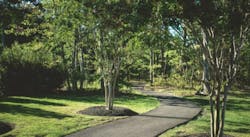Meeting the Demand for Green Features
As all home builders know, amenity preferences among buyers can change frequently and are often fleeting. However, in recent years, the desire for green features in homes has remained strong and is becoming an expectation. This isn't surprising given that the green single-family housing market in the U.S. has increased from $6 billion in 2005 to $87 billion in 2016, according to Statista, a statistics and analytics portal (Image Courtesy HHH Hunt Communities).
Similar trends are emerging for new-home communities as buyers demand more green community features. A recent survey from New Home Source found that green features in new homes and green amenities in new home communities are among the top 10 features that buyers want.
Literally Green
What do green features look like in today’s new home community? The most significant change has been the inclusion of more open green spaces. These spaces are passive and less programmed. Pocket parks are a great example of these open green spaces. They should be convenient to neighborhood pods and connected by walking trails. Larger open green space near community pavilions and clubhouses are popular as well. So are wooded areas that allow residents to enjoy and explore nature.
These open spaces offer a number of advantages. First, they encourage community building. Neighbors are more likely to share these spaces and interact on them. They’re not overly programmed areas so they serve multiple uses and can allow for many neighbors to share them simultaneously. Second, these green spaces support active lifestyles by facilitating places where neighbors can exercise or spend time outdoors. This benefit aligns with broader efforts across the country to encourage more outdoor play, especially among kids. From the NFL’s “Play 60” initiative to First Lady Michelle Obama’s “Let’s Move” program, facilitating active lifestyles is an important goal that these green spaces support.
Community green features also should be incorporated into clubhouses and common area structures.
Environmentally Green
In addition to incorporating more passive green space in new home neighborhoods, there are a number of green features that offer both environmental and financial benefits. These amenities will enhance a community and ensure it remains sustainable from an environment perspective. The added bonus is that these features will save the community’s homeowners and/or HOA money, making the community more viable in the long term.
- LED Lighting: Replacing traditional metal halide lighting with LED lights can deliver significant energy savings. Comparing two communities that we developed, the community utilizing LED lighting is saving an average of 50% on its energy costs per year in common spaces. LED lights also have lower maintenance costs and provide more even light distribution.
- Xeriscaping: What began in mostly drought-afflicted areas is spreading across the country as new home communities rely on landscaping designs that incorporate native plant materials and reduce the need for supplemental water from irrigation. Xeriscaping ensures that we’re serving as responsible stewards of the environment.
- Stormwater Irrigation: Water is becoming an increasingly important commodity and in addition to xeriscaping, reusing stormwater for irrigation is a great way to save costs and protect the environment. Even where water is plentiful, like Virginia, stormwater irrigation is becoming a common practice and some new home communities have saved thousands of dollars a year with stormwater irrigation.
New-home builders and developers should consider incorporating all of these green features into their communities. Not only will you meet the demands of homebuyers, but you’ll position your new home communities for extended sustainability.

